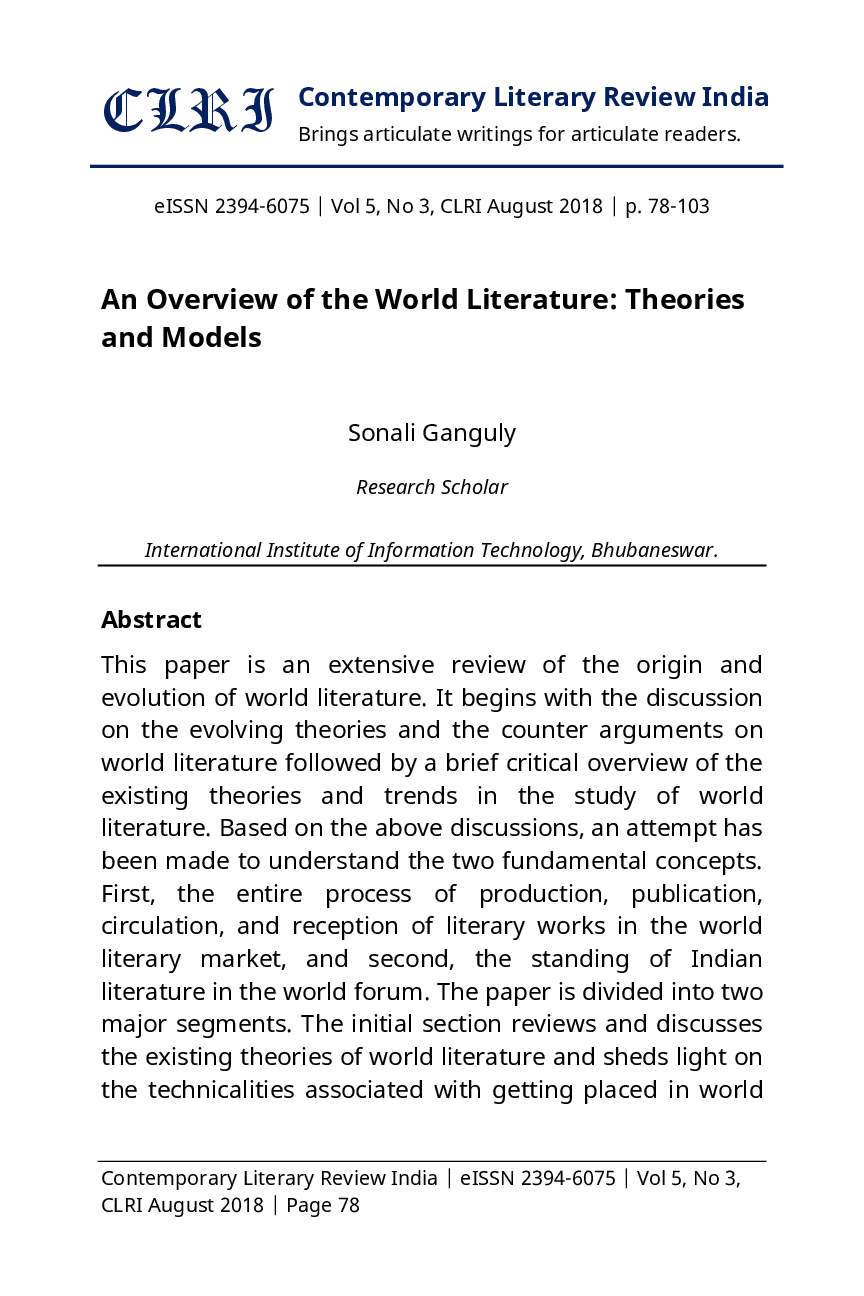
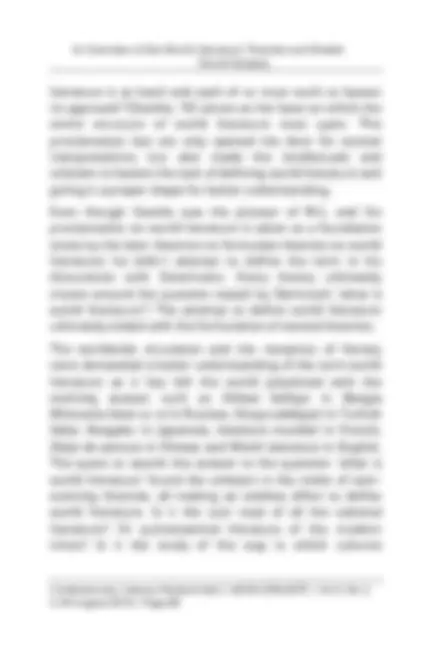
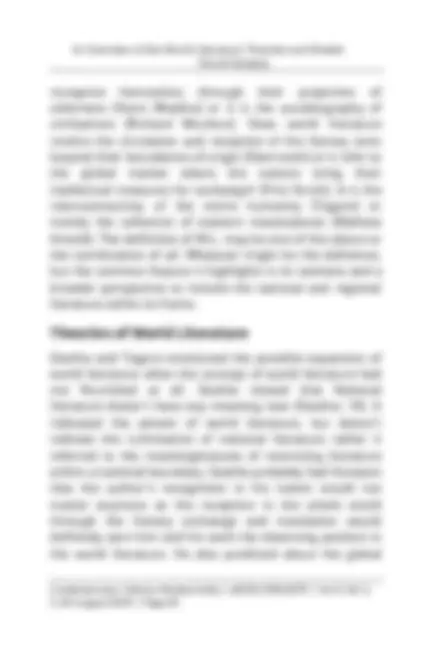
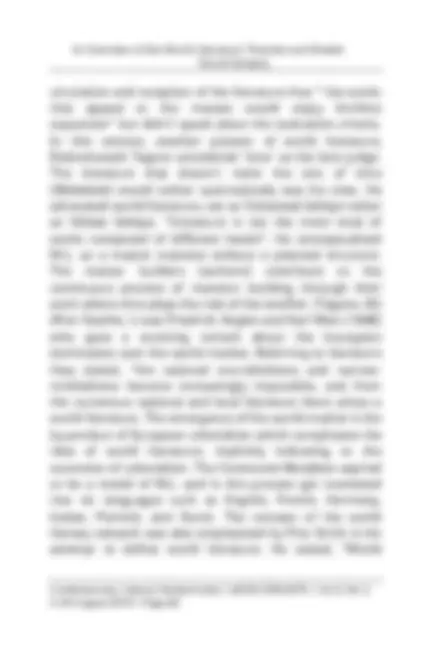
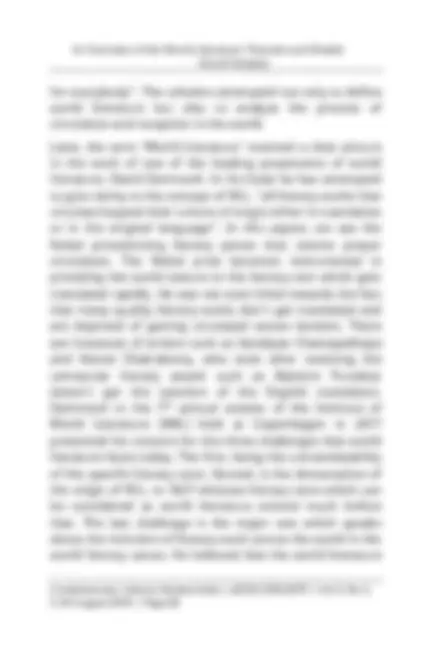
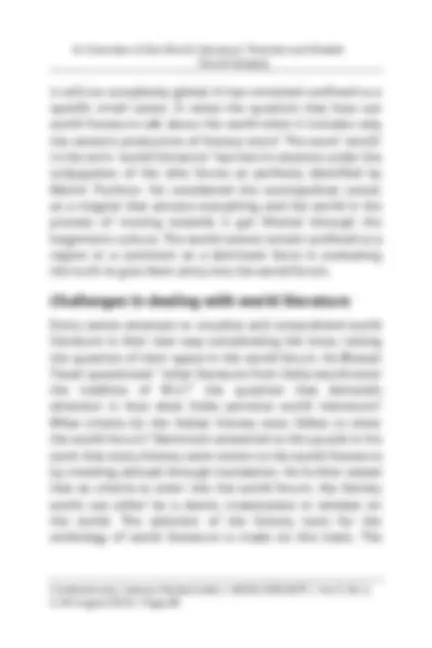
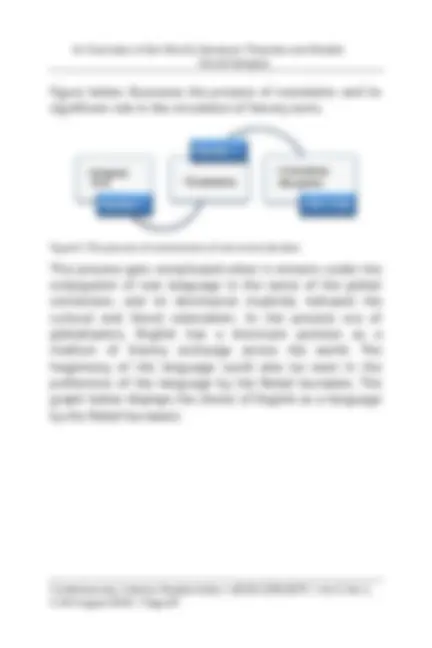
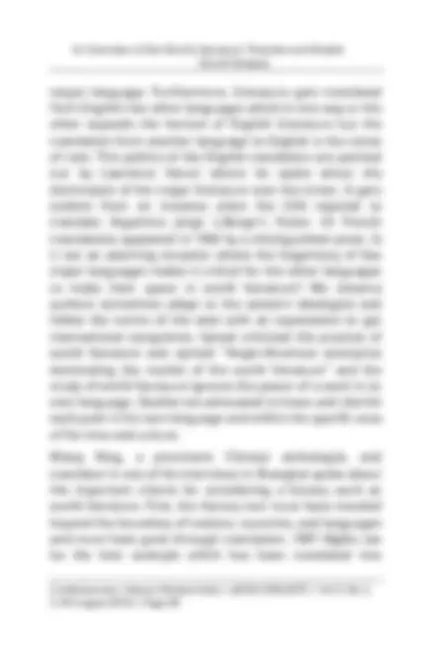
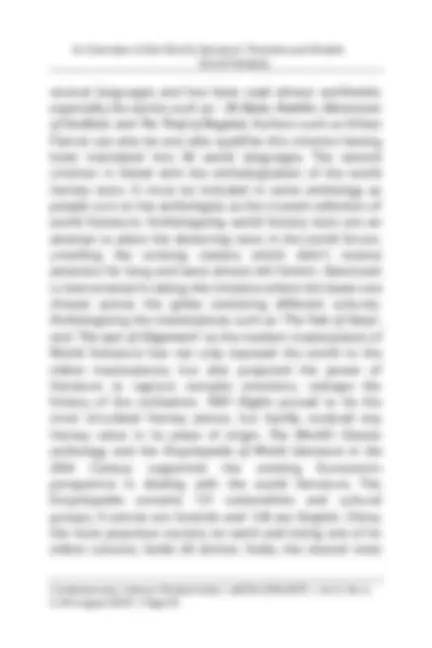
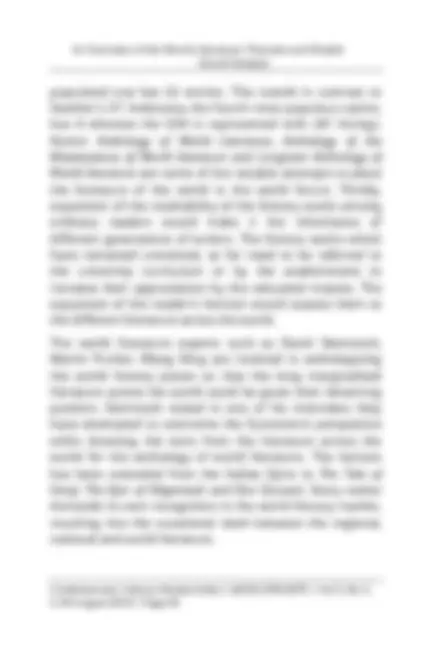
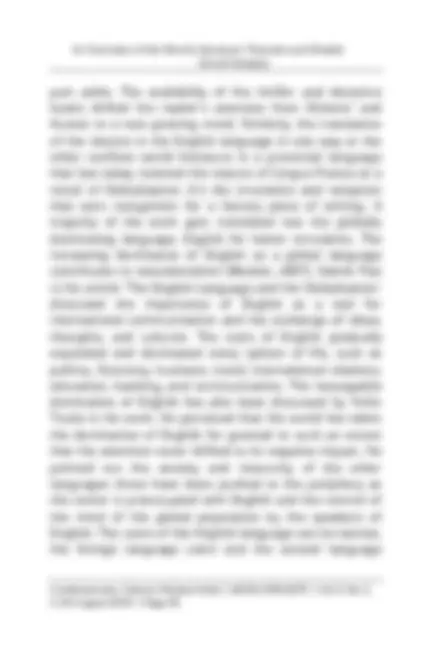
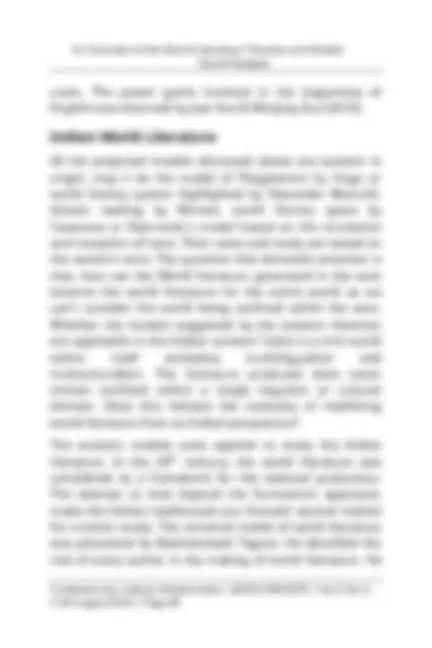
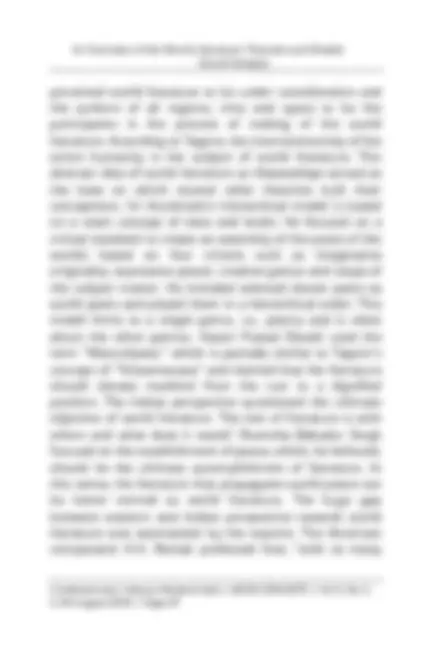
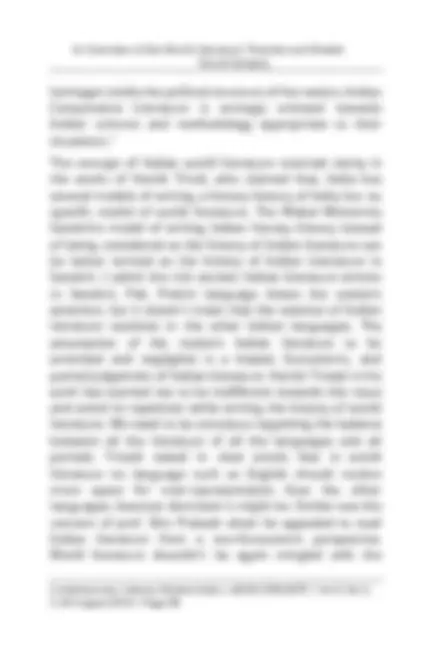
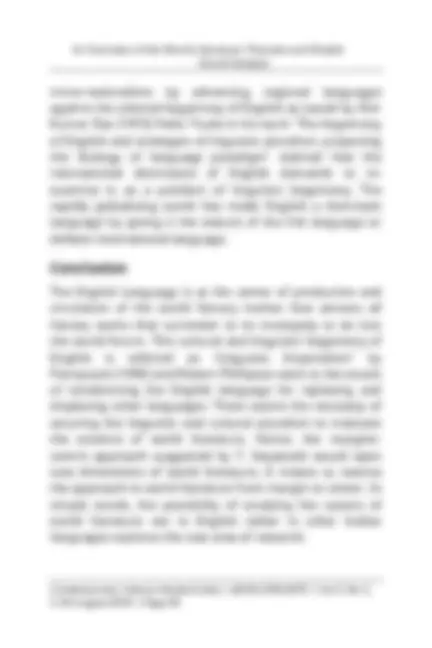
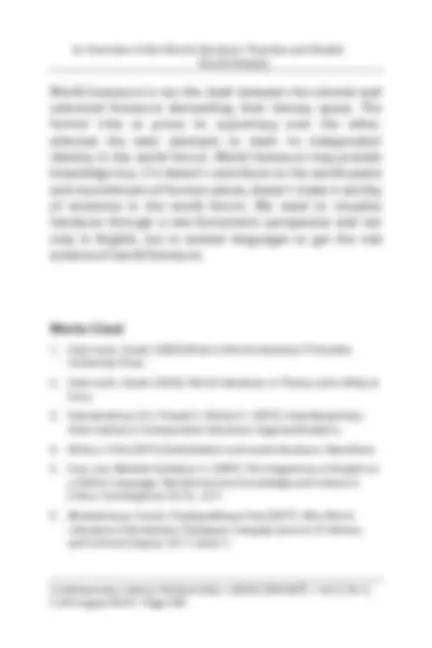

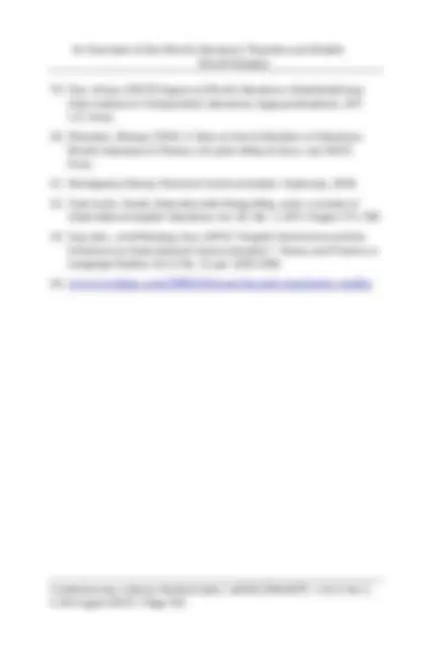
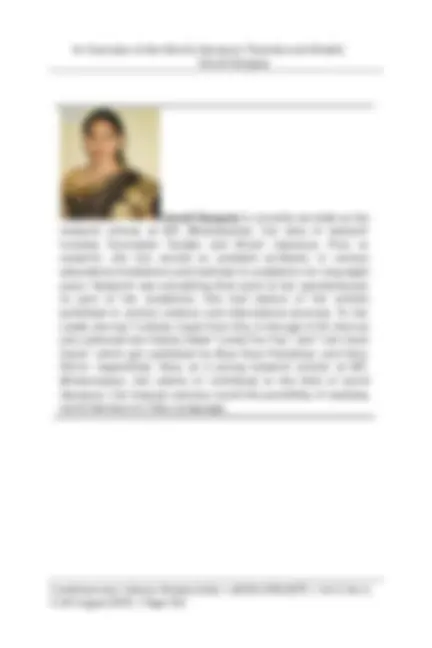



Study with the several resources on Docsity

Earn points by helping other students or get them with a premium plan


Prepare for your exams
Study with the several resources on Docsity

Earn points to download
Earn points by helping other students or get them with a premium plan
Community
Ask the community for help and clear up your study doubts
Discover the best universities in your country according to Docsity users
Free resources
Download our free guides on studying techniques, anxiety management strategies, and thesis advice from Docsity tutors
Abstract. This paper is an extensive review of the origin and evolution of world literature. It begins with the discussion on the evolving theories and the ...
Typology: Exams
1 / 27

This page cannot be seen from the preview
Don't miss anything!




















Brings articulate writings for articulate readers.
eISSN 2394-6075 | Vol 5, No 3, CLRI August 2018 | p. 78-
Contemporary Literary Review India | eISSN 2394-6075 | Vol 5, No 3,
An Overview of the World Literature: Theories
and Models
Sonali Ganguly
Research Scholar
International Institute of Information Technology, Bhubaneswar.
Abstract
This paper is an extensive review of the origin and evolution of world literature. It begins with the discussion on the evolving theories and the counter arguments on world literature followed by a brief critical overview of the existing theories and trends in the study of world literature. Based on the above discussions, an attempt has been made to understand the two fundamental concepts. First, the entire process of production, publication, circulation, and reception of literary works in the world literary market, and second, the standing of Indian literature in the world forum. The paper is divided into two major segments. The initial section reviews and discusses the existing theories of world literature and sheds light on the technicalities associated with getting placed in world
Sonali Ganguly
Contemporary Literary Review India | eISSN 2394-6075 | Vol 5, No 3,
literature. The consequent segment of the paper highlights the challenges associated with world literature.
Keywords
World literature, Globalization, Production, Reception, Circulation, Translation
Introduction
World literature (W.L) as a discipline has received a significant momentum since the19th century. The long list of intellectuals and scholars from almost every corner of the world, starting from Goethe to Damrosch, Casanova to Gayatri Spivak and Milan Kundera have not only projected their respective views to define this new discipline but also broadened the dimension of world literature. These discussions re-framed the idea of national literature and world literature.
The origin of world literature can be traced back to Weimar, where we can find Goethe’s prolonged discussions with Eckermann on the reception of numerous literary works of several cultures and languages. He appreciated the reception of the literary work moving beyond linguistically and politically drawn cultural borders through increased translation activities. The idea of world literature was generated from his inclination towards reading literature across the world such as Chinese, Persian, Arabic, Siberian, Sanskrit, including German and many more either in translation or in the original language. His over quoted statement- “the epoch of World
Sonali Ganguly
Contemporary Literary Review India | eISSN 2394-6075 | Vol 5, No 3,
recognize themselves through their projection of otherness (Homi Bhabha) or it is the autobiography of civilizations (Richard Moulton). Does world literature involve the circulation and reception of the literary texts beyond their boundaries of origin (Damrosch) or it refer to the global market where the nations bring their intellectual treasures for exchange? (Fritz Strich). Is it the interconnectivity of the entire humanity (Tagore) or merely the collection of western masterpieces (Mathew Arnold). The definition of W.L. may be one of the above or the combination of all. Whatever might be the definition, but the common feature it highlights is its vastness and a broader perspective to include the national and regional literature within its frame.
Theories of World Literature
Goethe and Tagore envisioned the possible expansion of world literature when the concept of world literature had not flourished at all. Goethe viewed that National literature doesn't have any meaning now (Goethe; 19). It indicated the advent of world literature, but doesn’t indicate the culmination of national literature rather it referred to the meaninglessness of restricting literature within a national boundary. Goethe probably had foreseen that the author’s recognition in his nation would not matter anymore as the reception in the whole world through the literary exchange and translation would definitely earn him and his work the deserving position in the world literature. He also predicted about the global
Sonali Ganguly
Contemporary Literary Review India | eISSN 2394-6075 | Vol 5, No 3,
circulation and reception of the literature that “ the works that appeal to the masses would enjoy limitless expansion” but didn’t speak about the evaluation criteria. In this context, another pioneer of world literature, Rabindranath Tagore considered ‘time’ as the best judge. The literature that doesn’t resist the test of time ( Mahakala ) would wither automatically was his view. He advocated world literature, not as Tulnatmak Sahitya rather as Vishwa Sahitya. “Literature is not the mere total of works composed of different hands”. He conceptualized W.L. as a master mansion without a planned structure. The master builders (authors) contribute to the continuous process of mansion building through their work where time plays the role of the testifier. (Tagore, 55) After Goethe, it was Friedrich Angles and Karl Marx (1848) who gave a stunning remark about the bourgeois domination over the world market. Referring to literature they stated, “the national one-sidedness and narrow- mindedness become increasingly impossible, and from the numerous national and local literature there arises a world literature. The emergence of the world market is the by-product of European colonialism which complicates the idea of world literature; implicitly indicating to the extension of colonialism. The Communist Manifesto aspired to be a model of W.L. and in this process got translated into six languages such as English, French, Germany, Italian, Flemish, and Dutch. The concept of the world literary network was also emphasized by Fritz Strich in his attempt to define world literature. He stated, “World
Sonali Ganguly
Contemporary Literary Review India | eISSN 2394-6075 | Vol 5, No 3,
of language and culture? The Chinese scholar, Zheng Zhenduo (1922), also emphasized the need for the global unity of literature in spite of differences between literature arising from the locality, nationality, time period, and style to make it world literature. The partial attainment of world literature is reflected in the work of Pascale Casanova(
The concept of world literature may not be the same for all the scholars. Every scholar has a unique perspective towards world literature as Amiya Dev viewed “if you want me to define world literature, I may say it is the sum total of texts available to me at this moment, translations included. Its fool to say that world literature would be one
Sonali Ganguly
Contemporary Literary Review India | eISSN 2394-6075 | Vol 5, No 3,
for everybody”. The scholars attempted not only to define world literature but also to analyze the process of circulation and reception in the world.
Later, the term ‘World Literature’ received a clear picture in the work of one of the leading proponents of world literature, David Damrosch. In his book he has attempted to give clarity to the concept of W.L. “all literary works that circulate beyond their culture of origin either in translation or in the original language”. In this aspect, we see the Nobel prizewinning literary pieces that receive proper circulation. The Nobel prize becomes instrumental in providing the world stature to the literary text which gets translated rapidly. He was not even blind towards the fact that many quality literary works don’t get translated and are deprived of getting circulated across borders. There are instances of writers such as Sandipan Chattopadhaya and Kamal Chakraborty, who even after receiving the vernacular literary award such as Bamkim Puraskar doesn’t get the sanction of the English translation. Damrosch in the 7th^ annual session of the Institute of World Literature (IWL) held at Copenhagen in 2017 presented his concern for the three challenges that world literature faces today. The first, being the untranslatability of the specific literary texts. Second, is the demarcation of the origin of W.L. to 1827 whereas literary texts which can be considered as world literature existed much before that. The last challenge is the major one which speaks about the inclusion of literary work across the world in the world literary canon. He believed that the world literature
Sonali Ganguly
Contemporary Literary Review India | eISSN 2394-6075 | Vol 5, No 3,
figure below illustrates the process of translation and its significant role in the circulation of literary texts.
Figure1: The process of transmission of text across borders
This process gets complicated when it remains under the subjugation of one language in the name of the global connection, and its dominance implicitly indicates the cultural and literal colonialism. In the present era of globalization, English has a dominant position as a medium of literary exchange across the world. The hegemony of the language could also be seen in the preference of the language by the Nobel laureates. The graph below displays the choice of English as a language by the Nobel laureates:
language 2
Sonali Ganguly
Contemporary Literary Review India | eISSN 2394-6075 | Vol 5, No 3,
Figure II- The Preference for the English Language by the Nobel laureates It’s the circulation and reception that earn recognition for a literary piece of writing. A majority of the work gets translated into the globally dominating language, English for better circulation. The increasing dominance of English as a global language contributes to neocolonialism (Beckett, 2007). The hegemony of the English language in the name of exposure to the world market, huge circulation pushes behind the minority languages establishing an unthreatened domination in world literature. The emerging writers of India get their recognition through the west as the books written by them get published and prized in the west. So, they enter
0
5
10
15
20
25
30
English^ French German Spanish Swidish^ Italian Russian^ Polish^ Danish Norwegian
Chinese Greek Japanese
Arabic Bangla^ Czech Finnish Hebrew Hungarian^ Icelandic^ Provencal Portuguese Serbo-Croatian
Turkish Yiddish
Number
Languages
Noble Laureates wrote in the Languages
Sonali Ganguly
Contemporary Literary Review India | eISSN 2394-6075 | Vol 5, No 3,
target language. Furthermore, Literature gets translated from English into other languages which in one way or the other expands the horizon of English Literature but the translation from another language to English is the rarest of rare. This politics of the English translation are pointed out by Lawrence Venuti where he spoke about the domination of the major literature over the minor. It gets evident from an instance when the USA rejected to translate Argentine Jorge L.Borge’s fiction till French translations appeared in 1950 by a distinguished press. Is it not an alarming situation where the hegemony of few major languages makes it critical for the other languages to make their space in world literature? We observe authors sometimes adapt to the western ideologies and follow the norms of the west with an expectation to get international recognition. Spivak criticized this practice of world literature and opined “Anglo-American enterprise dominating the market of the world literature” and the study of world literature ignores the power of a work in its own language. Goethe too advocated to know and cherish each poet in his own language and within the specific area of his time and culture.
Wang Ning, a prominent Chinese anthologist, and translator in one of his interviews in Shanghai spoke about the important criteria for considering a literary work as world literature. First, the literary text must have traveled beyond the boundary of nations, countries, and languages and must have gone through translation. 1001 Nights can be the best example which has been translated into
Sonali Ganguly
Contemporary Literary Review India | eISSN 2394-6075 | Vol 5, No 3,
several languages and has been read almost worldwide, especially the stories such as – Ali Baba, Aladdin, Adventures of Sindbad, and The Thief of Bagdad. Authors such as Orhan Pamuk can also be one who qualifies this criterion having been translated into 50 world languages. The second criterion is linked with the anthologization of the world literary texts. It must be included in some anthology as people turn to the anthologies as the trusted collection of world literature. Anthologizing world literary texts are an attempt to place the deserving texts in the world forum, unveiling the existing classics which didn’t receive attention for long and were almost left forlorn. Damrosch is instrumental in taking this initiative where the books are chosen across the globe consisting different cultures. Anthologizing the masterpieces such as ‘ The Tale of Genji ’, and ‘ The epic of Gilgamesh ’ as the modern masterpieces of World literature has not only exposed the world to the oldest masterpieces, but also projected the power of literature to capture complex emotions, reshape the history of the civilization. 1001 Nights proved to be the most circulated literary pieces, but hardly received any literary value in its place of origin. The World’s Classics anthology and the Encyclopedia of World Literature in the 20th Century supported the existing Eurocentric perspective in dealing with the world literature. The Encyclopedia contains 131 nationalities and cultural groups, 9 entries are Scottish and 138 are English. China, the most populous country on earth and being one of its oldest cultures, holds 28 entries. India, the second most
Sonali Ganguly
Contemporary Literary Review India | eISSN 2394-6075 | Vol 5, No 3,
The restricted scope of world literature is exhibited by Damrosch in his work when it comes to the reception of the world texts. In the words of Damrosch “Reception of a text depends on American interests and needs than with a genuine openness to other culture.” The literary pieces get access to the international reception through a wide network controlled by France, Britain and United States. The reception is also dependent upon a wide circulation of the texts through translation and the rate of readership it earns.
Translation in World Literature
Translation receives a prominent role in the circulation of world literary texts. It serves to assemble a fragmentary world. Susan Bassnett has a remarkable contribution in the field of translation studies. She focused on the essential role of a translator in establishing a link between the author and new target readers. She further stated that, translation connects the languages and ways of life. In her book, Translation Studies, she referred to translation as a means of encouraging the readers to return to the original Source text. Several emerging issues of translations re also addressed by Leferve and Bassnett in their books The Translator’s Invisibility and Translators as Writers respectively. Their discussions highlighted the role of a translator in maintaining transparency in the translation to such an extent that it seems less like a translation. Arguments are also raised in the favor of the translators being the creative writers. Emily Apter in her
Sonali Ganguly
Contemporary Literary Review India | eISSN 2394-6075 | Vol 5, No 3,
work ‘Against World Literature’ advocated the concept of ‘Untranslatability’. Harrison and Spivak too spoke in the same tone. Harrison in his work ‘World Literature: what gets lost in translation?’ emphasized on the need for reading the literary texts in their original language to find out what exactly is lost in translations. He also emphasized on language learning without which the study of World Literature remains incomplete. Gayatri Spivak (2003) too assumed that the threat of monolingualism invading comparative literature would result in the English language textbooks becoming pervasive globally. Martin Puchner in his recent paper “Goethe, Marx and Ibsen” addressed to issues raised by Apter and stated that the impossibility of a perfect translation is used to draw the conclusion that good translation is not only imperfect but also impossible. Experts such as Sujeet Mukherjee, Sandipan Bhattaharya, Arka Chattopadhaya in their work “Why World Literature” questioned the standing of Indian Literature in the world forum. The concern is about the marginalized literature and the languages as well in the name of Globalization. The study of globalization in relation to world literature focuses on several directions.
Globalization has changed the approaches to study literature as it has made the production, circulation and reception easier than ever. The development of print culture has seen massive publication of books keeping in mind the reader’s interest and habit. The commercial attitude of the publishing houses has resulted in the emergence of popular literature pushing the aesthetic
Sonali Ganguly
Contemporary Literary Review India | eISSN 2394-6075 | Vol 5, No 3,
users. The power game involved in the hegemony of English was observed by Jiao Xue & Wenjing Zuo (2013).
Indian World Literature
All the projected models discussed above are western in origin; may it be the model of Polyglottism by Hugo or world literary system highlighted by Alexander Beecroft, distant reading by Moretti, world literary space by Casanova or Damrosch’s model based on the circulation and reception of texts. Their cases and study are based on the western texts. The question that demands attention is that, how can the World literature generated in the west become the world literature for the entire world as we can't consider the world being confined within the west. Whether the models suggested by the western theorists are applicable in the Indian context? India is a mini world within itself embodies multilingualism and multiculturalism. The literature produced does never remain confined within a single linguistic or cultural domain. Does this indicate the necessity of redefining world literature from an Indian perspective?
The western models were applied to study the Indian literature. In the 20th^ century, the world literature was considered as a framework for the national production. The attempt to look beyond the Eurocentric approach, made the Indian intellectuals put forward several models for a better study. The universal model of world literature was pioneered by Rabindranath Tagore. He identified the role of every author in the making of world literature. He
Sonali Ganguly
Contemporary Literary Review India | eISSN 2394-6075 | Vol 5, No 3,
perceived world literature to be under consideration and the authors of all regions, time and space to be the participants in the process of making of the world literature. According to Tagore, the interconnectivity of the entire humanity is the subject of world literature. This abstract idea of world literature as Viswasahitya served as the base on which several other theorists built their conceptions. Sri Aurobindo’s hierarchical model is based on a static concept of class and levels. He focused on a critical standard to create an assembly of the poets of the worlds based on four criteria such as imaginative originality, expressive power, creative genius and scope of the subject matter. He included selected eleven poets as world poets and placed them in a hierarchical order. This model limits to a single genre, i.e., poetry and is silent about the other genres. Hazari Prasad Diwedi used the term “Manushyata,” which is partially similar to Tagore’s concept of “Viswamanava” and claimed that the literature should elevate mankind from the rust to a dignified position. The Indian perspective questioned the ultimate objective of world literature. The test of literature is with whom and what does it stand? Shamsha Bahadur Singh focused on the establishment of peace, which, he believed, should be the ultimate accomplishment of literature. In this sense, the literature that propagates world peace can be better termed as world literature. The huge gap between western and Indian perspective towards world literature was ascertained by the experts. The American comparatist H.H. Remak professed that, “with so many